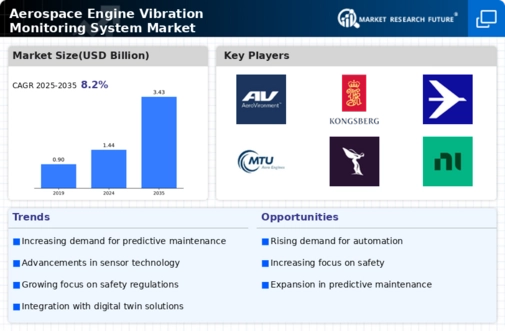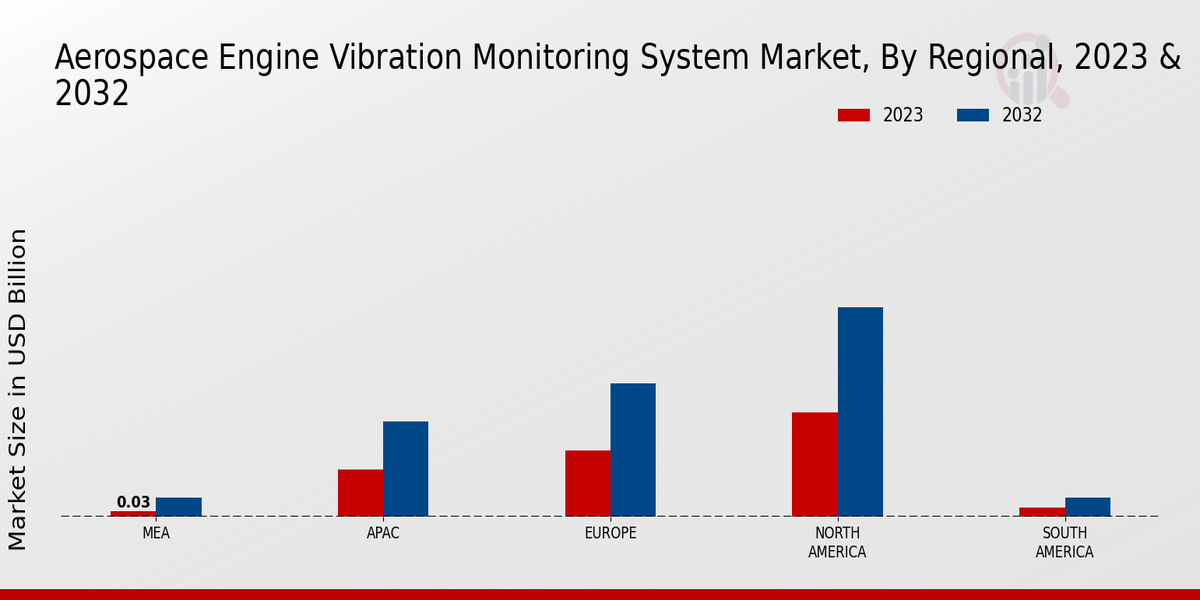Regulatory Compliance
Stringent regulatory frameworks governing aviation safety and emissions are driving the Global Aerospace Engine Vibration Monitoring System Market Industry. Regulatory bodies, such as the Federal Aviation Administration and the European Union Aviation Safety Agency, mandate regular monitoring of engine vibrations to ensure compliance with safety standards. This regulatory pressure compels airlines and manufacturers to invest in advanced monitoring systems, thereby expanding the market. The increasing focus on sustainability and reducing carbon footprints further emphasizes the need for effective vibration monitoring, as it aids in optimizing engine performance and minimizing emissions.
Focus on Fuel Efficiency
The aerospace industry's increasing emphasis on fuel efficiency is a significant driver for the Global Aerospace Engine Vibration Monitoring System Market Industry. Engine vibrations can adversely affect fuel consumption, leading to higher operational costs. By implementing vibration monitoring systems, operators can optimize engine performance, thereby improving fuel efficiency and reducing emissions. This focus on sustainability aligns with global efforts to minimize the environmental impact of aviation, further driving the adoption of advanced vibration monitoring technologies.
Market Growth Projections
The Global Aerospace Engine Vibration Monitoring System Market Industry is projected to witness substantial growth, with estimates indicating a rise from 1.44 USD Billion in 2024 to 3.43 USD Billion by 2035. This growth trajectory reflects a compound annual growth rate of 8.21% from 2025 to 2035, highlighting the increasing importance of vibration monitoring systems in the aerospace sector. The market's expansion is likely driven by technological advancements, regulatory compliance, and the growing demand for predictive maintenance solutions.
Technological Advancements
The Global Aerospace Engine Vibration Monitoring System Market Industry is experiencing a surge in technological advancements, particularly in sensor technology and data analytics. Innovations such as fiber optic sensors and advanced algorithms enhance the accuracy of vibration measurements, enabling real-time monitoring of engine performance. This is crucial for predictive maintenance, which can reduce operational costs and improve safety. As a result, the market is projected to grow from 1.44 USD Billion in 2024 to 3.43 USD Billion by 2035, reflecting a robust CAGR of 8.21% from 2025 to 2035.
Increasing Aircraft Fleet Size
The expansion of the global aircraft fleet is a pivotal driver for the Global Aerospace Engine Vibration Monitoring System Market Industry. As airlines continue to invest in new aircraft to meet rising passenger demand, the need for effective engine monitoring systems becomes paramount. The growing fleet size necessitates enhanced maintenance protocols, including vibration monitoring, to ensure operational efficiency and safety. This trend is expected to propel the market forward, as more aircraft require advanced monitoring solutions to comply with safety regulations and optimize performance.
Growing Demand for Predictive Maintenance
The shift towards predictive maintenance in the aerospace sector significantly influences the Global Aerospace Engine Vibration Monitoring System Market Industry. By utilizing vibration monitoring systems, operators can identify potential engine failures before they occur, thus minimizing downtime and maintenance costs. This proactive approach is increasingly favored over traditional maintenance strategies, which are often reactive. As airlines and operators recognize the financial benefits of predictive maintenance, the demand for sophisticated vibration monitoring solutions is expected to rise, contributing to the market's growth trajectory.























Leave a Comment